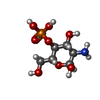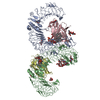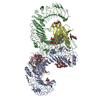登録情報 データベース : EMDB / ID : EMD-37831タイトル Cryo-EM Structure of Human TLR4/MD-2/DLAM3 Complex 複合体 : human TLR4/MD2/DLAM3 complexタンパク質・ペプチド : Toll-like receptor 4タンパク質・ペプチド : Lymphocyte antigen 96リガンド : 2-amino-2-deoxy-4-O-phosphono-alpha-D-glucopyranoseリガンド : 2-acetamido-2-deoxy-beta-D-glucopyranoseリガンド : (3R)-3-(dodecanoyloxy)tetradecanoic acidリガンド : (3R)-3-(tetradecanoyloxy)tetradecanoic acidリガンド : 2-(hydroxymethyl)-5-methoxy-3,6-bis(oxidanyl)pyran-4-one / / / / / 機能・相同性 分子機能 ドメイン・相同性 構成要素
/ / / / / / / / / / / / / / / / / / / / / / / / / / / / / / / / / / / / / / / / / / / / / / / / / / / / / / / / / / / / / / / / / / / / / / / / / / / / / / / / / / / / / / / / / / / / / / / / / / / / / / / / / / / / / / / / / / / / / / / / / / / / / / / / / / / / / / / / / / / / 生物種 Homo sapiens (ヒト)手法 / / 解像度 : 2.9 Å Fu Y / Kim H / Kim HM 資金援助 Organization Grant number 国 Other government Institute for Basic Science, IBS
ジャーナル : Nat Commun / 年 : 2025タイトル : Structural insight into TLR4/MD-2 activation by synthetic LPS mimetics with distinct binding modes.著者 : Yaoyao Fu / Hyojin Kim / Dong Sun Lee / Ah-Reum Han / Holger Heine / Alla Zamyatina / Ho Min Kim / 要旨 : The mammalian pattern-recognition receptor TLR4/MD-2 (Toll-like receptor 4/myeloid differentiation factor-2) can be activated by a wide variety of pathogen-associated and endogenous molecules, with ... The mammalian pattern-recognition receptor TLR4/MD-2 (Toll-like receptor 4/myeloid differentiation factor-2) can be activated by a wide variety of pathogen-associated and endogenous molecules, with Gram-negative bacterial lipopolysaccharide (LPS) being the primary natural TLR4 agonist. Activation of TLR4 triggers cellular signaling that enables the beneficial innate immune responses and enhances adaptive immunity, thereby emphasizing the potential of TLR4 agonists for the management of diseases with an immunopathological background and for use as vaccine adjuvants. Given the challenges associated with LPS-derived products, including structural complexity, heterogeneity, toxicity, and species specificity, synthetic molecules targeting TLR4/MD-2 offer a promising alternative. Here, we elucidate the structural basis for the recognition of synthetic LPS-mimicking glycolipids, Disaccharide Lipid A Mimetics (DLAMs), by human and mouse TLR4/MD-2 through cryo-EM structures of six dimeric [TLR4/MD-2/ligand] complexes resolved at 2.2-3.1 Å. We reveal that the specific binding modes of DLAMs, distinct from those of LPS, are essential for the species-independent TLR4 agonistic activity. DLAMs function as a molecular bridge, effectively induce the dimerization of TLR4/MD-2 complexes through specific carbohydrate structure-relevant ligand-protein interactions. Our findings reveal the distinct molecular modes of TLR4 activation, and provide a structural basis for the rationale design and development of innovative, highly potent TLR4-targeting immunotherapeutics and adjuvants. 履歴 登録 2023年10月18日 - ヘッダ(付随情報) 公開 2024年10月23日 - マップ公開 2024年10月23日 - 更新 2025年5月14日 - 現状 2025年5月14日 処理サイト : PDBj / 状態 : 公開
すべて表示 表示を減らす
 データを開く
データを開く 基本情報
基本情報
 マップデータ
マップデータ 試料
試料 キーワード
キーワード 機能・相同性情報
機能・相同性情報 Homo sapiens (ヒト)
Homo sapiens (ヒト) データ登録者
データ登録者 韓国, 1件
韓国, 1件  引用
引用 ジャーナル: Nat Commun / 年: 2025
ジャーナル: Nat Commun / 年: 2025


 構造の表示
構造の表示 ダウンロードとリンク
ダウンロードとリンク emd_37831.map.gz
emd_37831.map.gz EMDBマップデータ形式
EMDBマップデータ形式 emd-37831-v30.xml
emd-37831-v30.xml emd-37831.xml
emd-37831.xml EMDBヘッダ
EMDBヘッダ emd_37831_fsc.xml
emd_37831_fsc.xml FSCデータファイル
FSCデータファイル emd_37831.png
emd_37831.png emd-37831.cif.gz
emd-37831.cif.gz emd_37831_half_map_1.map.gz
emd_37831_half_map_1.map.gz emd_37831_half_map_2.map.gz
emd_37831_half_map_2.map.gz http://ftp.pdbj.org/pub/emdb/structures/EMD-37831
http://ftp.pdbj.org/pub/emdb/structures/EMD-37831 ftp://ftp.pdbj.org/pub/emdb/structures/EMD-37831
ftp://ftp.pdbj.org/pub/emdb/structures/EMD-37831 emd_37831_validation.pdf.gz
emd_37831_validation.pdf.gz EMDB検証レポート
EMDB検証レポート emd_37831_full_validation.pdf.gz
emd_37831_full_validation.pdf.gz emd_37831_validation.xml.gz
emd_37831_validation.xml.gz emd_37831_validation.cif.gz
emd_37831_validation.cif.gz https://ftp.pdbj.org/pub/emdb/validation_reports/EMD-37831
https://ftp.pdbj.org/pub/emdb/validation_reports/EMD-37831 ftp://ftp.pdbj.org/pub/emdb/validation_reports/EMD-37831
ftp://ftp.pdbj.org/pub/emdb/validation_reports/EMD-37831 リンク
リンク EMDB (EBI/PDBe) /
EMDB (EBI/PDBe) /  EMDataResource
EMDataResource マップ
マップ ダウンロード / ファイル: emd_37831.map.gz / 形式: CCP4 / 大きさ: 103 MB / タイプ: IMAGE STORED AS FLOATING POINT NUMBER (4 BYTES)
ダウンロード / ファイル: emd_37831.map.gz / 形式: CCP4 / 大きさ: 103 MB / タイプ: IMAGE STORED AS FLOATING POINT NUMBER (4 BYTES) 試料の構成要素
試料の構成要素 Homo sapiens (ヒト)
Homo sapiens (ヒト) Homo sapiens (ヒト)
Homo sapiens (ヒト) Trichoplusia ni (イラクサキンウワバ)
Trichoplusia ni (イラクサキンウワバ) Homo sapiens (ヒト)
Homo sapiens (ヒト) Trichoplusia ni (イラクサキンウワバ)
Trichoplusia ni (イラクサキンウワバ)


 解析
解析 試料調製
試料調製 電子顕微鏡法
電子顕微鏡法 FIELD EMISSION GUN
FIELD EMISSION GUN
 ムービー
ムービー コントローラー
コントローラー


























 Z (Sec.)
Z (Sec.) Y (Row.)
Y (Row.) X (Col.)
X (Col.)






































